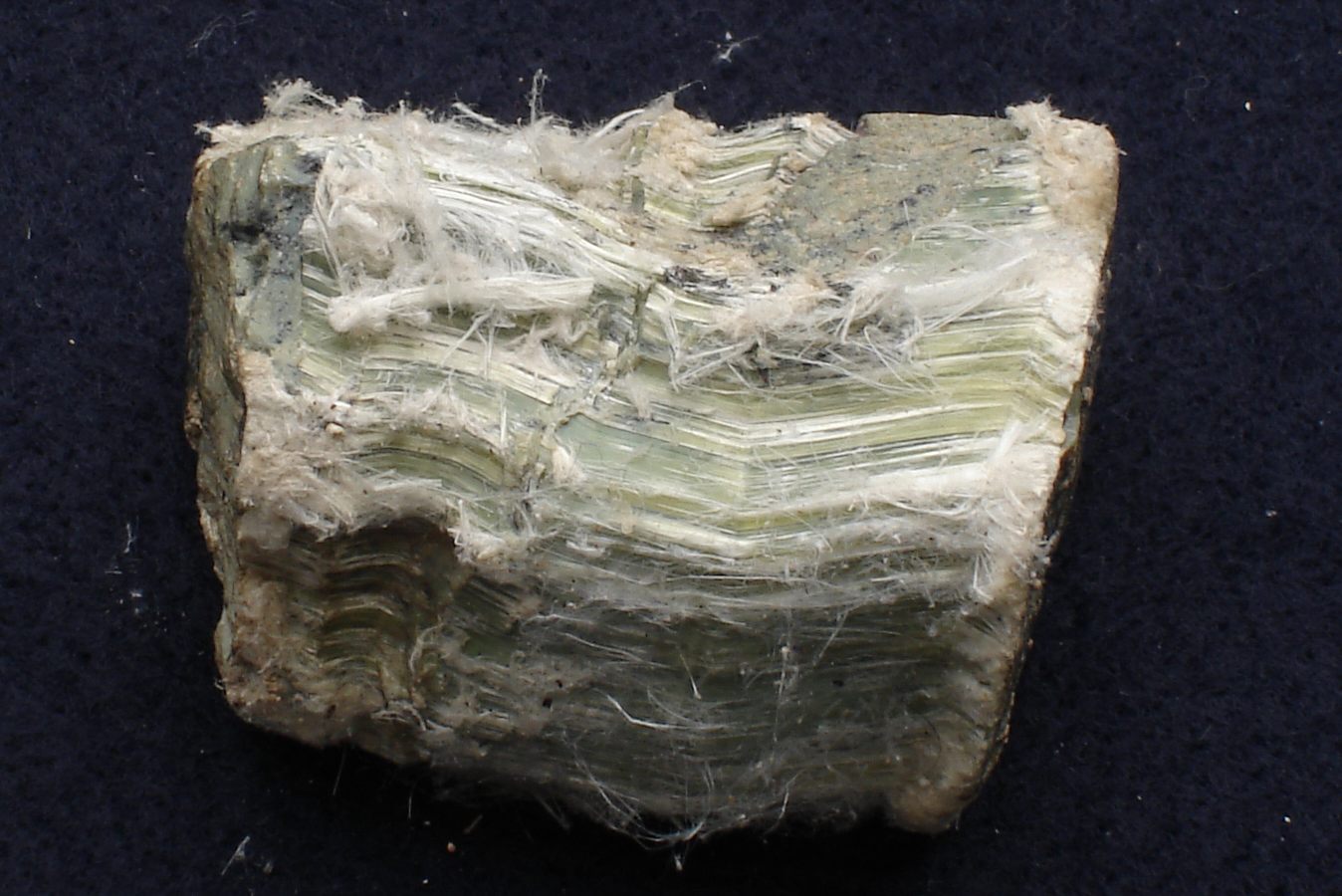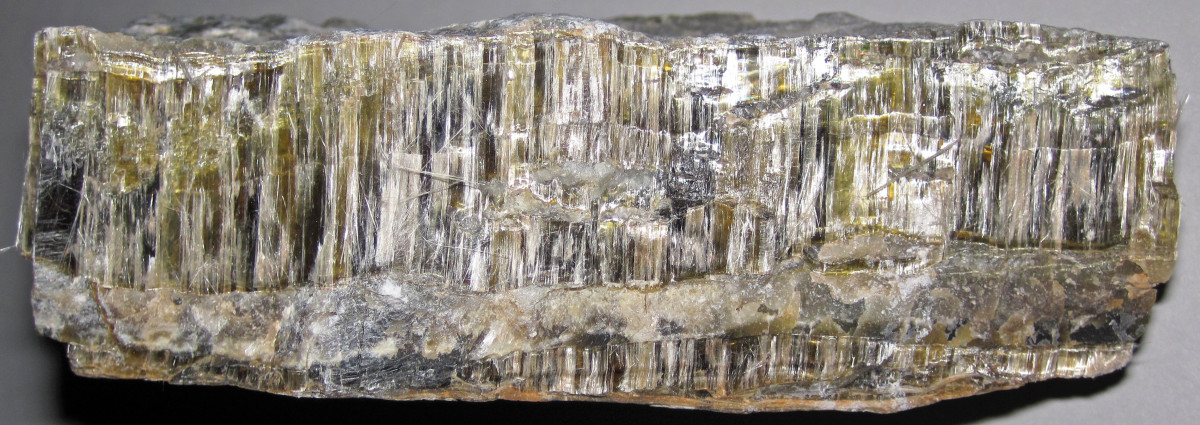
クリソタイル宝石:特性、意味、価値、安全性
 クリソタイルは蛇紋石の一種で、他の宝石の内包物としてよく見られます。有名な例としては、 デマントイドガーネットに含まれる馬の尾状の内包物が挙げられます。この内包物は、ガーネットの価値を大きく高めます。
クリソタイルは蛇紋石の一種で、他の宝石の内包物としてよく見られます。有名な例としては、 デマントイドガーネットに含まれる馬の尾状の内包物が挙げられます。この内包物は、ガーネットの価値を大きく高めます。
クリソタイルは岩石ですか?それとも鉱物ですか?クリソタイルは岩石ではなく鉱物です。この鉱物は「白アスベスト」とも呼ばれます。実際、クリソタイルアスベストは最も一般的に使用されているアスベスト鉱物です。
このガイドでは、クリソタイルの意味や鉱物特性から歴史や治癒力まで、クリソタイルに関するあらゆる情報を説明します。

クリソタイル石について
クリソタイルは半貴石であり、重要な工業用鉱物です。多くの名称で呼ばれていますが、そのほとんどは誤った名称です。誤った名称の例としては、以下のようなものがあります。
スイスグリーンオパール
ドラゴンの鱗石
ゼブラジャスパー
リザードスキンジャスパー
こうした誤った名称が使われる主な理由は、知識不足です。特に模様のある不透明な石は、その正体にかかわらず、販売者によって単に「 ジャスパー」と呼ばれることがあります。 オパールと比較されるのは、クリソタイルの密度がオパールに似ていることに由来すると考えられます。
もう一つよくある混同は、クリソタイルとクリソライトです。クリソライトはオリビンやペリドットを指す、やや古めかしい用語であり、クリソタイルとは全く異なるものです。
覚えておくべきコツは、クリソタイル(タイル床の「タイル」を思い浮かべてください)は建築に幅広く使用されている鉱物だということです。
ところで、クリソタイルは何に使われているのでしょうか?一言で言えば、たくさん使われています。
クリソタイルの用途
世界の産業用アスベストの90%以上はクリソタイルです。米国だけでも、クリソタイルの消費量は年間約13,000トンに上ります。
クリソタイルの用途には次のようなものがあります。
車両のブレーキライニングとパッド
ガスケット
屋根材(アスファルト)
セメントシート
ダクト、家電製品、ガスケット、パイプの断熱材
接着剤
ビニールタイル
耐火性、特に乾式壁
マグネシウムの供給源
用途がわかったところで、クリソタイルとはどのような鉱物なのでしょうか?
クリソタイルの仕様と特性
クリソタイルは蛇紋石グループに属する鉱物です。クリソタイルの近似化学式はMg3Si2O5(OH)4ですが、このグループの他の鉱物、リザーダイトやアンチゴライトにも当てはまります。これらはすべてマグネシウムを含む蛇紋石です。
クリソタイル蛇紋石は、アスベストグループに属し、蛇紋石と角閃石に分けられます。角閃石鉱物には、 アクチノライト、アンソフィライト、 トレモライト、クロシドライト(青石綿)、アモサイト(茶石綿)などがあります。
すべてのアスベスト鉱物は繊維状です。蛇紋石アスベストグループの鉱物は一般的に、結晶シート層からなる縮れた繊維を有し、一方、角閃石鉱物は針状(針状)の繊維を有します。
多くの角閃石鉱物はクリソタイルに混入するため、アスベスト中毒の危険性が高まります(角閃石アスベストは蛇紋石アスベストよりも毒性が強い)。アンソフィライト、トレモライト、アクチノライトは、いずれもクリソタイル、 タルク、バーミキュライトによく混入します。
クリソタイル結晶のその他の特性は次のとおりです。
モース硬度:2.5~3
色: 白、金褐色、灰色、緑、灰緑色。時には黄色、黄褐色、茶色。縞模様やまだら模様があることもある。
結晶構造:単斜晶系(クリノクリソタイル);斜方晶系(オルソキロスタイル、パラクリソタイル)
光沢:シルキー
透明度:半透明
屈折率:1.56~1.57
密度:2.51~2.63
胸の谷間:なし
骨折:線維性
縞模様:白
発光:淡黄色で弱い蛍光を発することがある
多色性:なし
光学的効果:時にはシャトヤンシー

クリソタイルの種類
クリソタイルには3つのポリタイプ、つまり互いに異形性を持つ鉱物があります。つまり、各タイプは同じ化学組成を持ちながら、結晶構造が互いに異なるということです。
クリノクリソタイル:最も一般的なタイプで、単斜晶系です。
オルソクリソタイル:斜方晶系で、繊維の長軸と平行な屈折率が高い希少なタイプ
パラクリソタイル:斜方晶系で、繊維の長軸に垂直な屈折率が高い非常に珍しいタイプ
知っておくべき重要なクリソタイルの種類が 3 つあります。
アルミニウムクリソタイル:アルミニウムを豊富に含む品種
クリソチラスベスト:アスベスト状の性状(柔軟で、細く、長く、折れにくい、分離しやすい繊維の集合体)を持つ変種
イシュキルダイト:他のクリソタイルとは異なる光学特性を持つシリカを多く含む変種
鉱物についてはよくご存知でしょうが、クリソタイル蛇紋石の意味についてはどう思われますか?
 画像クレジット: Eurico Zimbres | Creative Commons Attribution-Share Alike 2.5 Genericライセンス
画像クレジット: Eurico Zimbres | Creative Commons Attribution-Share Alike 2.5 Genericライセンス
クリソタイル石の意味と歴史
クリソタイルは、自己反省、強さ、そして回復力を象徴しています。スピリチュアルコミュニティでは「生命の石」と呼ばれています。また、このクリスタルは双子座の幸運の石でもあります。
グリーンゼブラジャスパー、アスベスト、またはドラゴンスケールストーンという誤った呼び名により、クリソタイルは、着用者が悪魔や不運を識別して回避するのに役立つという評判を過去に得ました。
しかし、クリソタイルの近代史の多くは、クリソタイルへの暴露の危険性に関するものである。
初期の歴史
まずはクリソタイルの発見から始めましょう。ドイツの鉱物学者フランツ・フォン・コーベルは、1843年にカナダ産のクリソタイル標本に初めて命名しました。彼はギリシャ語で「金」を意味するchrysosと「繊維」を意味するtilosにちなんで、石に含まれる金色の繊維にちなんで命名しました。
現在の名前が付けられる前、クリソタイルには次のような鉱物名がありました。
カナダのアスベスト
ファセルセルペンチン
クリソタイル-アルファまたはα-クリソタイル
クフォイト/クフォライト
レフカスベスト/レフカスベストス
ピクロスミン
サイフォイテ
カリストライト
クリソリス
アスベスト禁止
1900年代を通じて、米国ではアスベスト製品の大部分がクリソタイルで占められていました。実際、カナダと米国はかつてクリソタイルの主要な供給国でした。
では、クリソタイルはいつ禁止されたのでしょうか?
簡単に答えると?予想よりずっと遅いです。もう少し詳しく答えると:
アスベストの使用は紀元前2400年にまで遡り、紀元1世紀には病気との関連性を示唆する記録が残っています。しかし、アスベスト中毒に関する最初の公式記録は1924年の英国医学雑誌に掲載されました。
この医学記事は、1874年にカナダで最初の商業生産用アスベスト鉱山が開設されてから50年後に発表されました。アスベスト中毒、またはアスベスト症の最初の症状リストは、1930年代にERAメレウェザー博士によって発表されました。
英国では、メレウェザーの研究はアスベスト工場の労働者に対する政府の保護策の制定に貢献したが、製品を設置する労働者に対する保護策の制定にはつながらなかった。
1940年代には、アスベストが病気やがんを引き起こすという記録が数多く残されており、1949年にはブリタニカ百科事典がアスベストを「職業性および環境性がんの原因」と呼んでいます。その危険性を示す研究が山積みだったにもかかわらず、英国で本格的な規制が施行されたのは1969年になってからでした。
オーストラリアでは、クリソタイルは2003年から禁止されている。政府は1960年代にアスベストの使用を段階的に廃止し始めていた。
1970年代、米国はアスベスト肺症に関する規制を整備し始めました。環境保護庁(EPA)は1990年代初頭にアスベストの段階的廃止を試みましたが、米国の裁判所はこれを阻止しました。
2022 年 4 月 5 日現在、EPA は製造業者、設置業者、消費者を保護するためにクリソタイルアスベストの禁止を制定しようとしています。
安全性については「お手入れとメンテナンス」のセクションで詳しくご説明します。では、今は精神的な健康について、クリソタイルの治癒効果についてお話ししましょう。
 画像クレジット: James St. John | Flickr
画像クレジット: James St. John | Flickr
クリソタイルの治癒特性
すべての宝石はヒーリングストーンとして機能しますが、その力は色によって左右されます。多くのクリソタイルは緑色で、他の緑色の宝石と同様に、活力と成長を促進します。
黄色のクリソタイルには、希望、喜び、創造性を高めるといった黄色のクリスタルの効能があります。一方、茶色のクリソタイルには、 茶色の宝石の持つグラウンディングとバランス調整の作用があります。
身体的、感情的、チャクラのヒーリングの具体的な用途についてはどうでしょうか?
身体の治癒
クリソタイルには、それほど多くの身体的な治癒力はありません。クリソタイルヒーリングストーンの主な身体的な用途は、血液循環と視力に関する問題の治療です。
感情的な癒し
クリソタイルには、感情を癒す力があるとされ、ネガティブな思考や行動パターンを解放する効果も期待されています。また、過去の感情的な苦難を乗り越える際に、自己意識を守り、冷静さを保ち、失敗から学ぶことで、自分を責めることなく、前向きな気持ちでいられるとも言われています。
チャクラヒーリング
チャクラ ストーンは、ブロックされたエネルギー センター (チャクラ) を開いて負の症状を解決する古代の慣習で使用されます。
ご存知の通り、宝石の色は癒しの効果に影響を与えます。他の白い宝石と同様に、ホワイトクリソタイルはクラウンチャクラのチャクラストーンであり、精神的な上昇と高次の意識へと導きます。
一方、グリーンクリソタイルは、ハートチャクラのバランスを整え、自分自身と他人への愛情をもたらすチャクラストーンです。
オープンハートは感情的に価値がありますが、宝石としてのクリソタイルの価値は何でしょうか?
クリソタイル宝石の特性
ほとんどの宝石と同様に、クリソタイルの価値は、それぞれの石が色、カット、透明度、処理のどのカテゴリーに該当するかによって決まります。
色
「白アスベスト」という名前にもかかわらず、宝石として研磨され販売されるクリソタイルのほとんどは灰色または緑色です。ほとんどの場合、縞模様や斑点模様があり、白と灰色、または中緑から濃緑と白の縞模様が多いです。茶色や黄色のものもあります。
カット
クリソタイル石はほぼすべて、 カボションカット、球形カット、またはタンブルカットで作られています。ペンダントやイヤリングには、カボションカットのクリソタイル石がよく見られます。 ファセットカットのクリソタイル石はほとんど存在しません。
塔やハート、杖などの彫刻が施されたクリソタイルも見られることがあります。
明瞭さ
デマントイドガーネットに信じられないほどの価値を与える稀少な馬の尾状の内包物に加えて、他の石に含まれるほとんどのクリソタイル内包物は石の価値を下げます。
クリソタイル自体に含まれる内包物はあまり一般的ではありません。しかし、石の繊維が他の内包物と同様に機能し、シャトヤンシー、つまり「キャッツアイ効果」と呼ばれる貴重な光学現象をもたらすことがあります。
治療
多くのクリソタイル石は、より鮮やかな色や興味深い色に染められます。また、安定性と耐久性を高めるために樹脂を含浸させることもあります。
一般的に、処理(特に染色)は石の価値を下げるので、販売者はクリソタイル石(または他の宝石)が処理されているかどうかを常に開示する必要があります。
 画像クレジット: James St. John | Flickr
画像クレジット: James St. John | Flickr
クリソタイルの形成と供給源
クリソタイル鉱物の典型的な形成過程は、アンチゴライトやリザーダイトのそれと似ており、超塩基性岩石の熱水変質作用(低度変成作用とも呼ばれます)です。
ミネラル豊富な水が岩の割れ目に浸透すると、内部の鉱物が変化します。以前の鉱物は新しい鉱物に変化します。この場合、カンラン石や斜方輝石は通常、クリソタイルに変化します。
クリソタイルを含む一般的な岩石は、変質したドロマイト石灰岩と蛇紋岩です。
採掘場所
クリソタイルはどこで採掘されていますか? クリソタイルの主要生産国は以下のとおりです。
ブラジル
カナダ
中国
カザフスタン
ポーランド
ロシア
ジンバブエ
重要な購入者の質問に移りましょう: クリソタイル宝石の価格はいくらですか?
 画像クレジット: James St. John | Creative Commons Attribution 2.0 Genericライセンス
画像クレジット: James St. John | Creative Commons Attribution 2.0 Genericライセンス
クリソタイルの価格と価値
一般的に販売されているクリソタイルの主な形状は、カボションとタンブルストーンです。多くは、中緑から濃緑、または灰色から黒のベースに白い縞模様が入っています。
クリソタイルのカボションやタンブルストーンは非常にお手頃価格です。ほとんどが1カラットあたり1ドル以下で、個々の石は1個あたり約5ドルから8ドルです。
ハート、塔、杖などの彫刻は 1 つあたり約 15 ドルと少し高くなりますが、大きいサイズのオプションでは 1 つあたり約 30 ドルになることもあります。
クリソタイルの安全性とケア
宝石のケアについて議論する前に、クリソタイルの安全な取り扱い方について見ていきましょう。幸いなことに、角閃石アスベスト鉱物は蛇紋石アスベストよりもはるかに危険ですが、だからといってクリソタイルが完全に安全というわけではありません。
まず、クリソタイルの含有量が多いとはどういうことでしょうか?ほとんどの専門家は、どんな量でも危険だと言います。しかし、クリソタイルの危険性は、放出された繊維を吸入した場合です。したがって、研磨された石は、粉砕されない限り、危険ではありません。
とはいえ、宝石研磨師はクリソタイルをカットする際には、隔離された作業エリア、マスクやアイカバー、手袋などの適切な安全装備など、予防措置を講じる必要があります。さらに、多くの安全専門家は、乾いた状態でカットすると繊維が放出されやすくなるため、石が濡れている状態でカットすることを推奨しています。
日常的に購入する人は、粗い標本の取り扱いには注意する必要があり、理想的には繊維の吸入を防ぐために密閉容器に保管する必要があります。
宝石のケアについて!
宝石のケア
クリソタイルは水には溶けませんが、その繊維は薄めた酸の中で分解し始めるので、石に酸を近づけないでください。
クリソタイルジュエリーの場合、 モース硬度スケールにおける石のランクが低いことを考慮して、 保護設定をお勧めします。
(研磨済みの)クリソタイルは、一般的な柔らかい歯ブラシ、ぬるま湯、そして中性洗剤で洗浄できます。傷がつかないように、他の宝石とは分けて保管してください。
クリソタイルクリスタルが欲しくなりますか?
アスベストのせいで敬遠しないでください。研磨されたクリソタイル石は安全に使用できるだけでなく、感情的な癒しや邪気から身を守るなど、多くのメリットがあります。お手頃な価格と目を引く模様で、きっと気に入っていただけるはずです。
Gemstone Encyclopedia検索
最新記事
レインボーラティスサンストーンは、様々な内包物によって3つのゴージャスな光学的効果を持つ長石の一種です。燃えるように鮮やかな色合いと格子模様が、コレクターにとって希少な宝石となっています。
12th Jan 2026
チューライトは、ゾイサイト鉱物ファミリーに属する、鮮やかなバラ色の色合いを示す希少なノルウェー産の宝石で、ジュエリーのセッティングやペンダントによく使用されます。
6th Jan 2026
記事のカテゴリ
How To's is where you will find helpful articles from gem Rock Auctions on how to cut gemstones, select gemstones and buy gemstones.
9記事数

